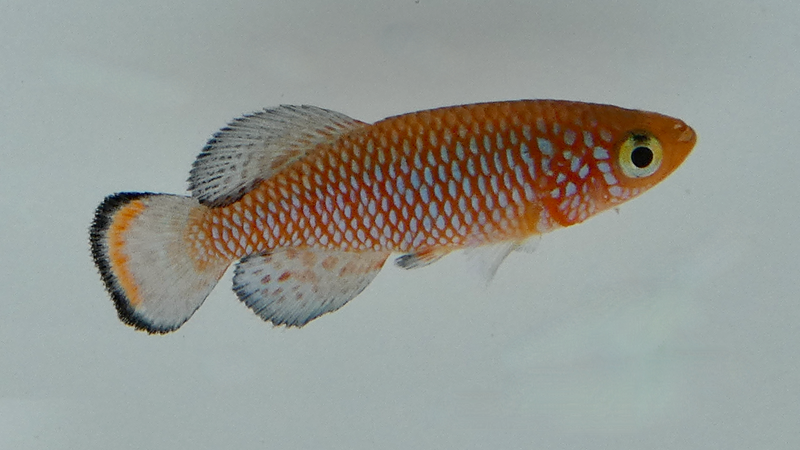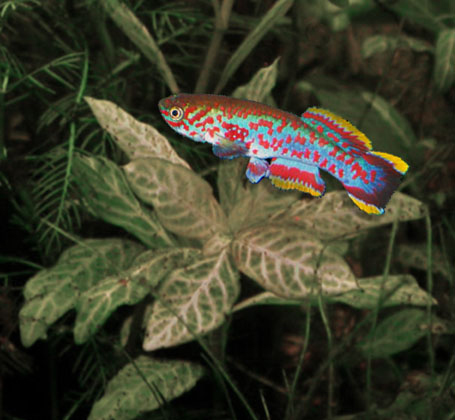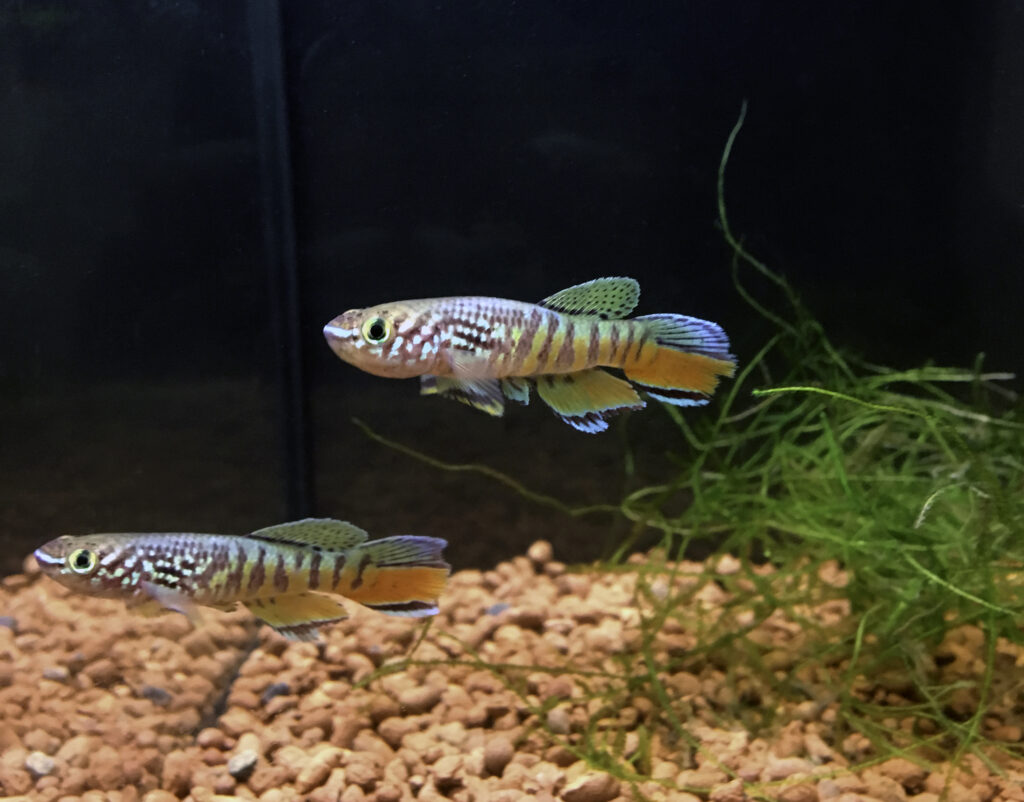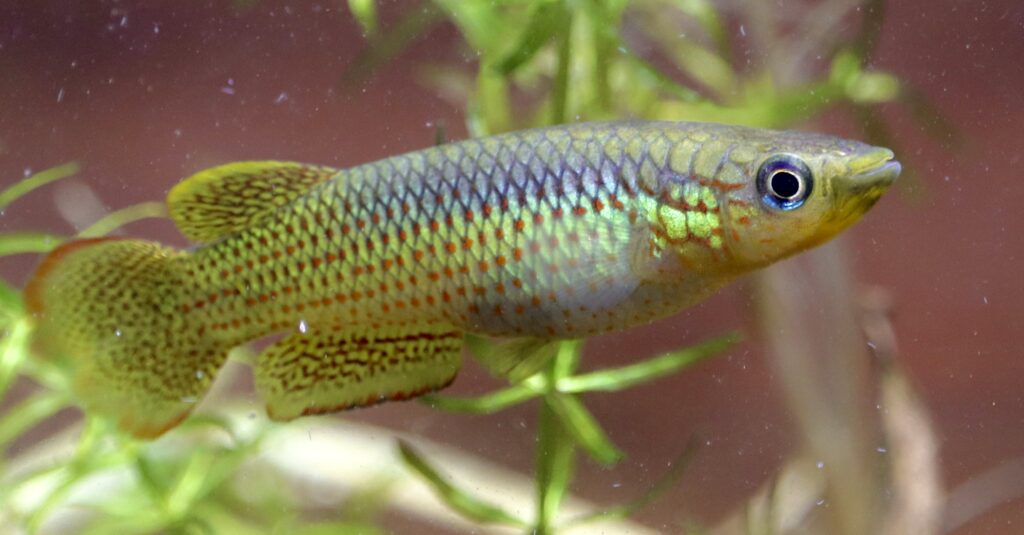Killifish are broken down into 5 families:
- Aplocheilidae
- Cyprinodontidae
- Fundulidae
- Profundulidae
- Valenciidae
In total, there are ~1,270 different species of Killifish. While there are over 1,000 different species, a lot of their characteristics are very similar – if not the same. In this blog post, you will learn 9 interesting facts about this super interesting and beautifully aesthetic species.
1. Are Killifish Aggressive?
First from my personal experience – yes – towards other aggressive species. While doing research for this blog post I also read numerous discussion forum posts that reported their Killifish to be aggressive as well – especially towards fish that are commonly found on the “Killifish Compatibility Charts”. The best explanation that I found was where someone compared them to Cichlids.

Cichlids are known to be an aggressive fish. They can be kept in large schools or even a few specific species that are compatible with other specific species that are not cichlids – however, overall they are known to be aggressive. With that said, the same goes for the Killifish – some specific species are cool with cohabitating with specific species and others are not.
This is why it is recommended that if you are going to keep Killifish that you do so in a species only aquarium. When they breed the male can become very aggressive, so it is recommended that you keep about 3 females to every male – at the minimum.

I personally have a female Gardneri Panchax Killifish in my 40 gallon aquarium with 3 black mollies, 2 Koi Platies, 5 Green Corydora Catfish, 2 Otocinclus Catfish and a couple of snails. She was not very nice to the other fish at first but now they all live together just fine. Although, if you can avoid it, I would keep the Killifish on it’s own in a species only tank following the recommended male to female ratio.
2. Are Killifish a Schooling Fish?
Building off of the recommended Killifish male to female ratio – Killifish tend to do very well when kept in a species only aquariums. So the only “school” that will work for them is the 1 male to at least 3 females ratio guideline.
3. Are Killifish Livebearers?
Killifish are egg layers however, it is believed that their genetic lineage goes back to commonly kept in the aquarium species such as mollies and swordtails – which are livebearers. So they may have evolved from that species and then adapted their egg laying breeding practices due to their environment – but don’t really know for certain. What we do know, however, is that they are not livebearers.

4. Are Killifish Community Fish?
As long as the females outnumber the male by a minimum of 3, Killifish can be kept in a “community” aquarium of other Killifish. It is typically not a good idea to keep them in a community tank even though I personally have been successful with one female in my 40 gallon freshwater tank – and I’m sure that other aquarists have had similar success. It’s just not worth the risk. I was told by a very knowledgeable person at my local fish store that they would get along – and they ultimately did – however, they did not initially and I almost had to bring her back to the store. Nowadays they all get along fine but in the future if I want to keep more Killifish, I will be setting up a species only aquarium for them.
5. How Do Killifish Breed?
The eggs are fertilized internally and then the female Killifish will lay her eggs. Depending on the species this can be in the sand, in peat moss, etc. From there, depending on the species and lifespan category, the eggs will hatch, the fry will grow, they will mature and the cycle will repeat itself.
In captivity, breeders use a yarn mop which the female will lay her clear fertilized eggs into. Depending on the individual breeder’s preferred technique will determine the hatching method. Here are 2 different methods from 2 different Killifish breeders/YouTubers breeding 2 different species of Killifish:
YouTuber Fish Boy‘s method:
YouTuber Blake’s Aquatics method:
6. What Do Killifish Eat?
Killifish like a high protein diet. With that said, the protein can come from a high protein fish pellet, live fruit flies, brine shrimp, mysis shrimp, mosquito larva and worms. The food can also be frozen.
7. How Long Do Killifish Live?
While the actual origin of the Killifish’s name is uncertain, one explanation offers the Dutch word kil for a kill also known as a small stream. The Killifish that have a lifespan of a couple of years are primarily found in permanent brackish bodies of water with the types ranging from streams, rivers and lakes. Killifish with shorter lifespans are found in temporary bodies of water such as ponds and floodplains.

As far as age goes, the Killifish is broken into three categories:
- Annual: The shortest lifespan of all species of Killifish ranging from 3 months up until 9 months at the most. They are found in seasonal ponds that eventually dry up every year. Most tend to become sexually mature within 3 weeks of hatching. Their eggs require a “dry period” before they hatch. This is the time period between when the pond dries up until it is refilled again. And thus the cycle of life restarts for another season for this species.
- Semi-Annual: These Killifish have a lifespan of anywhere between 2 and 5 years. They live in waterways that may dry up at some point but not every year. Their eggs can also be kept viable during a period of time if need be.
- Non-Annual: These species of Killifish are the ones that are commonly found in the aquarium hobby and live in permanent bodies of water. They also have a lifespan of 2 to 5 years.
8. How Big Do Killifish Get?
The smallest Killifish gets from 1 to 2 inches in length. The largest species of Killifish gets to be about 6 inches in length.
9. Are Killifish Easy to Keep in an Aquarium?
When kept in a species only aquarium the general consensus is yes. There are, however, quite a few factors that you need to consider when keeping Killifish as pets. This will be determined by the specific species that you are interested in keeping. Here are 5 recommendations from YouTuber Aquarium Co-Op:
Once you have selected the species that you are interested in keeping, do a search online for “[Your Species Name] Killifish Care” in order to find that specie’s specific aquarium habitat requirements. A good starting point once you are finished reading this blog post and watching Aquarium Co-Op’s video above, is from YouTuber The Nerdy Fish Girl. Here is her Beginner Care Guide on Killifish in general:
